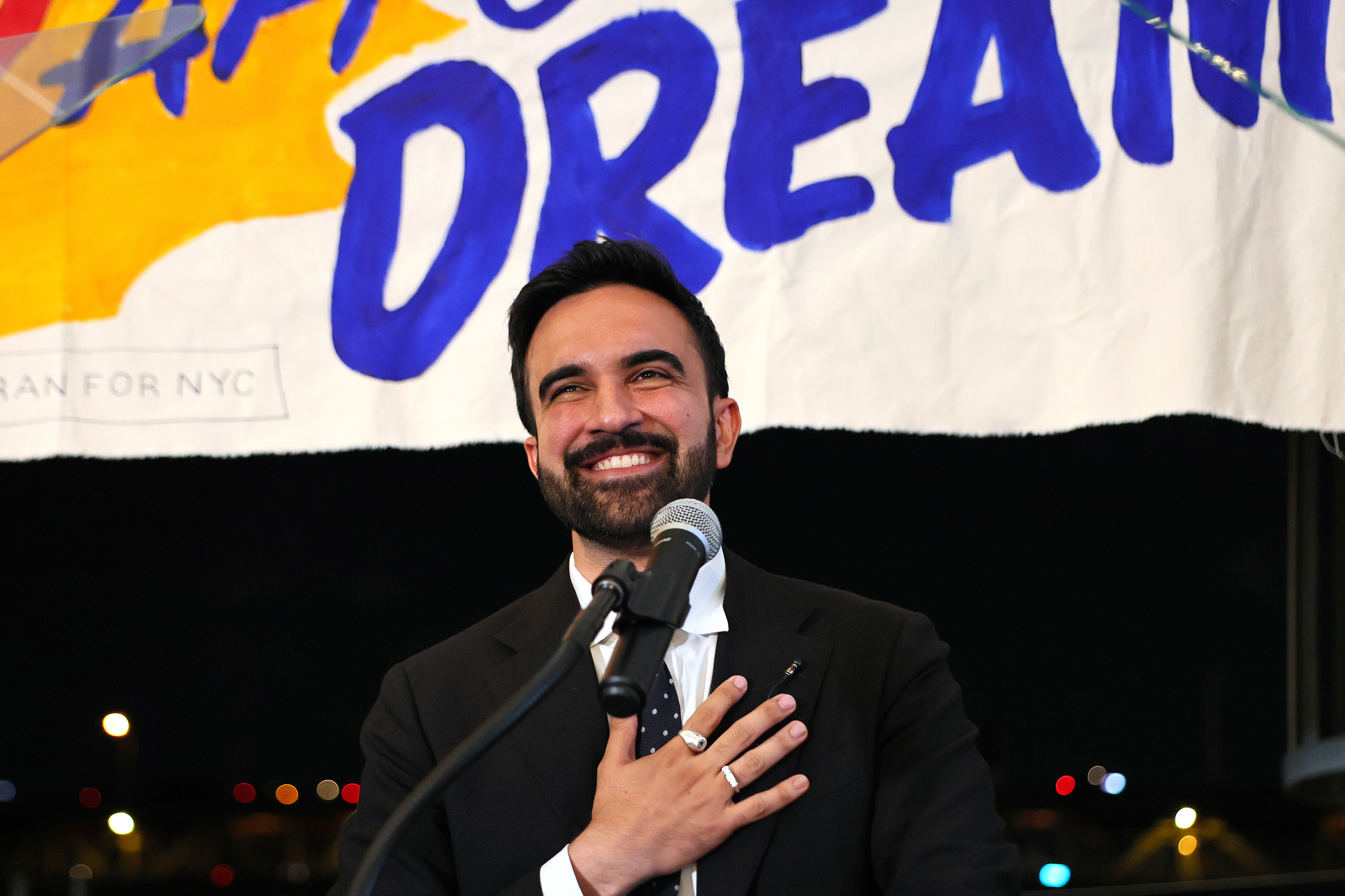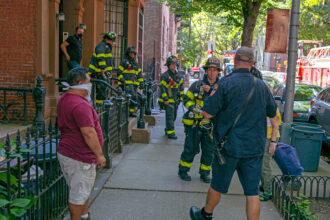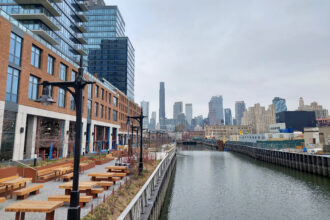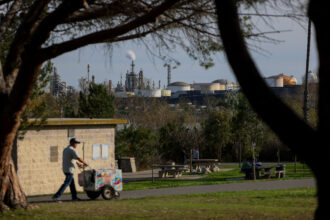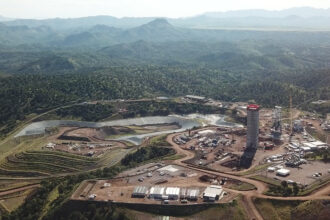On June 24, the day of the New York City primary, Central Park hit its highest temperature for the day—99 degrees—since 2012. That morning, the city’s emergency notification system, NotifyNYC, alerted residents that they should conserve power, implying that there was a risk of blackouts.
By the evening, Con Edison, the city’s main electricity provider, reported that 6,386 residents were out of service in the area.
Like many things in New York City, the dangers of extreme heat are not spread out equally across the city. Some residents are more at risk because they live in areas with less tree cover and green space, and taller buildings, leading to higher temperatures than in neighborhoods with large parks.
Some residents have chronic health conditions like asthma, often brought on because they live in areas with heavy truck traffic, which can make them more vulnerable to the health impacts of extreme heat, especially since it worsens the local air quality.
Others cannot afford to buy an air conditioner for their home, or go to school in a building without reliable appliances.
Though Zohran Mamdani, the state assembly member who has now officially won the city’s Democratic mayoral primary, has not placed the climate crisis at the center of his campaign, he is focused on affordability, but has effectively woven climate issues into his push to improve the quality of life of the average New Yorker.
“Climate and quality of life are not two separate concerns,” he told the Nation earlier this year. “They are, in fact, one and the same.”
Mamdani was declared the winner of the primary after the third round of tabulations in the city’s ranked-choice voting system showed him defeating former New York governor Andrew Cuomo by 56 percent to 44 percent.
Both Cuomo and current Mayor Eric Adams will be on the ballot as independent candidates in November for the city’s mayoral election. Adams currently has a low approval rating among city voters. Last year, he was charged with bribery and campaign finance offenses by federal prosecutors—though he pleaded not guilty.
A federal judge dismissed the charges this past April—around two months after the Justice Department told prosecutors to drop the case because it was interfering with Adams’ ability to carry out President Trump’s immigration crackdown.
Fighting Fossil Fuel Infrastructure and Utility Rate Hikes
Mamdani was first elected to the state assembly in 2020, beating an incumbent for a chance to represent the district that encompasses Astoria, Ditmars-Steinway and Astoria Heights in Queens. He was reelected in 2022 and 2024.
Despite a thin track record—only three minor bills that he introduced were signed into law—Mamdani has enjoyed broad support from environmentalists and community organizations across the city.
Mamdani has a record of fighting polluting gas infrastructure, like the establishment of a natural gas plant in Astoria—a battle he ultimately won in 2022. The Department of Environmental Conservation denied NRG, the gas company, the air permit it needed, arguing that the project does not comply with the state’s Climate Act, which sets out ambitious goals to reduce greenhouse gas emissions in the state. This came after public pressure from city residents.
Kim Fraczek, the executive director of Sane Energy, a nonprofit organization that is advocating for the replacement of gas infrastructure with renewable energy, fought that gas plant along with Mamdani.
“I think he really was able to help political power listen to all of us on the ground,” said Fraczek. “He was great at speaking at rallies, marching with us in the street, and we had a very strong educational campaign.”
According to Fraczek, their protest was rooted in helping people in the area understand the health implications of living near a gas plant, which can lead to higher rates of respiratory illnesses.
Mamdani was also a staunch supporter of legislation like the Build Public Renewables Act, which was included in the state’s budget in 2023. It tasked the New York Power Authority, the state power utility, with building much of the renewable energy projects required to meet the state’s ambitious emissions targets—picking up the slack from the private sector.
But in just two years, the New York Power Authority has already fallen short of its goals. Earlier this year, it acknowledged in its draft plan that it would not be able to meet the state’s goal of a 70 percent renewable-sourced electricity grid until at least 2033, a delay of three years.
Mamdani was also vehemently opposed to the Con Edison utility rate hike in 2023. The increase was ultimately approved by the state’s Public Service Commission, effectively increasing the average New Yorker’s Con Ed electricity and gas bill by $64 a month by 2025.
“We did a very robust educational campaign—getting everyday residents of New York that are impacted by rate hikes to understand the connection between fracked gas infrastructure expansion and the cost of your monthly bills going up and the health implications,” said Fraczek.
Mamdani has also been a skilled communicator when it comes to connecting the issue of affordability in the city with climate action, climate activists say. He has supported the New York HEAT Act as a co-sponsor this year.
The bill would effectively cap utility bills at 6 percent of household income and end the 100-foot rule for gas hookups, a requirement that ratepayers subsidize the final piece of gas line infrastructure needed to connect new buildings to the system.
This past session, the New York Assembly voted to repeal the rule, with the bill currently on the governor’s desk.
Though Mamdani has supported a variety of climate-related causes, he has rarely been the architect behind the legislation. He promised a more active stance during his campaign for mayor.
Green Buildings and Green Schools
Mamdani’s platform largely concerns housing—a key tenet of making the city more affordable. The average rent in New York city for a one-bedroom is $4,025 a month, making it one of the most expensive cities in the country.
He plans to appoint a new rent guidelines board, which votes periodically on rent increases at rent-stabilized apartments across the city. Like former Mayor Bill De Blasio, Mamdani plans to appoint board members who are sure to vote for a rent freeze. According to a policy memo, he also plans to build 200,000 new affordable units over the next 10 years.
New York City’s buildings are responsible for nearly two thirds of the city’s emissions. Mamdani has shown support for a city law that went into effect earlier this year that tries to solve that problem by imposing slowly escalating limits on large buildings’ emissions—forcing landlords to pay a fine if they emit more than their fair share.
Mamdani pledged to uphold the law, named Local Law 97, at a mayoral forum in February, Inside Climate News reported. For many environmentalists who ended up door-knocking and canvassing for his campaign, this was a welcome change.
Mamdani “really understood that we need to go after these big polluters, and that we can’t let the real estate just curry favor with the executive in the same way they have with Eric Adams,” said Santosh Nandabalan, a senior climate campaigner with New York Communities for Change who canvassed for Mamdani in the city.
Adams has been accused by environmentalists of cozying up to the real estate groups, some of which have endorsed him, and adding loopholes to the law to soften the impact on landlords, like enabling them to buy Renewable Energy Credits in some cases, instead of forcing them to pay to electrify and better insulate their buildings—the ultimate goal of the law. The credits subsidize other renewable energy projects across the state.
Electrifying an older building, which requires moving the heating system off gas and toward electric heating appliances like heat pumps and induction stoves, can be an expensive process.
Co-ops and small-time landlords worry that they will struggle to meet the demands of the law. Mamdani has a plan to help them by increasing investments in NYC Accelerator—a program that helps landlords decarbonize their buildings—and by extending existing tax breaks.
Newer buildings are also by-and-large required to be built without gas appliances through another local law, so Mamdani’s new homes, if built, would likely not add to the burden of reducing city emissions.

Mamdani also has a very ambitious “Green Schools for a Healthier New York City” plan, which would renovate 500 schools across the city and fit them with renewable energy infrastructure as well as heating and cooling appliances.
He also hopes to turn their schoolyards into green spaces, to reduce extreme heat from asphalt playgrounds and limit flooding in the area by absorbing stormwater. Daniel Goulden, a strategy co-chair of the New York City Democratic Socialists of America Ecosocialist Working Group, helped design Mamdani’s “Green Schools” plan.
“We wanted to show a decarbonized future for New York City that is led by the city and state government and that is completely transformative to the ways people live,” Goulden said. “Schools seemed like the perfect thing to demonstrate that vision.”
Fifty schools would be turned into resilience hubs—places that operate normally like community spaces but become emergency shelters during natural disasters where community members can gather to stay safe from flooding, or during power outages.
Goulden believes that schools are currently underused as community spaces. These changes would all be done by union workers, creating a pipeline for young New Yorkers to join the green economy—an area which has been stagnating recently.
The feasibility of Mamdani’s plans has been questioned. The total cost of his Green Schools plan alone is estimated by his team to be $3.27 billion over 10 years. He asserts that the plan can be paid for by reallocating existing funds at the Department of Citywide Administrative Services and through green bonds released by the New York Green Bank, an investment fund dedicated to moving the state forward in its energy goals.
The plan would also require Mamdani to work with the New York Power Authority to install the renewable infrastructure, and get a waiver for the state’s maximum cost allowances—enabling him to spend more on decarbonizing local public schools.
This story is funded by readers like you.
Our nonprofit newsroom provides award-winning climate coverage free of charge and advertising. We rely on donations from readers like you to keep going. Please donate now to support our work.
Donate NowMamdani would have to get multiple state agencies on board with his plan, and likely the governor. Despite Mamdani’s promises, many of his other plans, like universal childcare and affordable housing, would require tax increases or other new sources of funding. For example, he plans to pay for some of his proposals through a 2 percent tax increase on those who make over $1 million a year.
Gov. Kathy Hochul told PIX11, a local news station, that “I’m not raising taxes at a time when affordability is the big issue.” She also worries about an exodus of the wealthy from the city if the tax increases were to go through.
“I don’t want to lose any more people to Palm Beach,” she told PIX11.
Linking Climate and Affordability
Like Boston Mayor Michelle Wu and other local politicians, Mamdani has linked climate to his campaign for a more affordable New York City.
“Climate is a policy issue, but it’s not a policy issue in the way other policy issues are,” said Goulden. “It’s connected to literally everything, so it needs to be integrated everywhere.”
Last year, Mamdani advocated for a fare-free bus pilot in which the MTA offered free service on five bus lines across New York City, one in each borough. The pilot, which ended last year, increased ridership by 30 percent on weekdays, and 38 percent on weekends, according to a report by the MTA.
Though the state legislature did not extend the pilot, Mamdani plans to institute fare-free buses across the city, while also increasing priority lanes and the number of loading zones.
In New York City, the buses are very slow, and idling buses contribute to the congestion issue in the city, leading to higher rates of asthma in neighborhoods close to busy highways.
The fare-free aspect of the plan would require approval from the state legislature, but the mayor usually has control of city street design.
“I think his campaign has been so notable and important for the climate movement because it really connects urban climate issues to making cities more livable for working-class families,” said John Qua, a campaign director at Lead Locally, an organization that supports city, county and state political candidates that want to address the climate crisis.
According to Qua, Lead Locally helped Mamdani amass public funds through phone banking and encouraged its New York-based supporters to donate to his campaign.
“A lot of times, when we talk about the ways that cities can take action on climate, on their emissions, it can feel disengaged from the concerns of just everyday people,” said Qua.
But Mamdani’s blend of affordability and climate-conscious rhetoric has not swayed everyone. According to the New York Times, Cuomo dominated in 59 percent of majority Black precincts—areas where 70 percent of the residents are Black—whereas Mamdani enjoyed widespread support in only 26 percent of them.
This comes despite the fact that communities of color in New York City are more likely to live near polluting infrastructure and are disproportionately more exposed to emissions from heavy-duty diesel vehicles, impacting local air quality. There is also stark wealth inequality between Black and white New York City residents.
Despite this, Qua remains optimistic. Like Nandabalan, he believes that a stronger emphasis on talking with voters in those neighborhoods can help swing the mayoral election in November to Mamdani.
“Focusing so intently on ensuring that our cities are affordable and livable—and not just for the wealthy—is so important for Democrats writ large across the country, but also for the climate movement,” said Qua. “We’ve got to remember, if our work isn’t to make people’s lives more livable, we’ve lost our way.”
About This Story
Perhaps you noticed: This story, like all the news we publish, is free to read. That’s because Inside Climate News is a 501c3 nonprofit organization. We do not charge a subscription fee, lock our news behind a paywall, or clutter our website with ads. We make our news on climate and the environment freely available to you and anyone who wants it.
That’s not all. We also share our news for free with scores of other media organizations around the country. Many of them can’t afford to do environmental journalism of their own. We’ve built bureaus from coast to coast to report local stories, collaborate with local newsrooms and co-publish articles so that this vital work is shared as widely as possible.
Two of us launched ICN in 2007. Six years later we earned a Pulitzer Prize for National Reporting, and now we run the oldest and largest dedicated climate newsroom in the nation. We tell the story in all its complexity. We hold polluters accountable. We expose environmental injustice. We debunk misinformation. We scrutinize solutions and inspire action.
Donations from readers like you fund every aspect of what we do. If you don’t already, will you support our ongoing work, our reporting on the biggest crisis facing our planet, and help us reach even more readers in more places?
Please take a moment to make a tax-deductible donation. Every one of them makes a difference.
Thank you,


